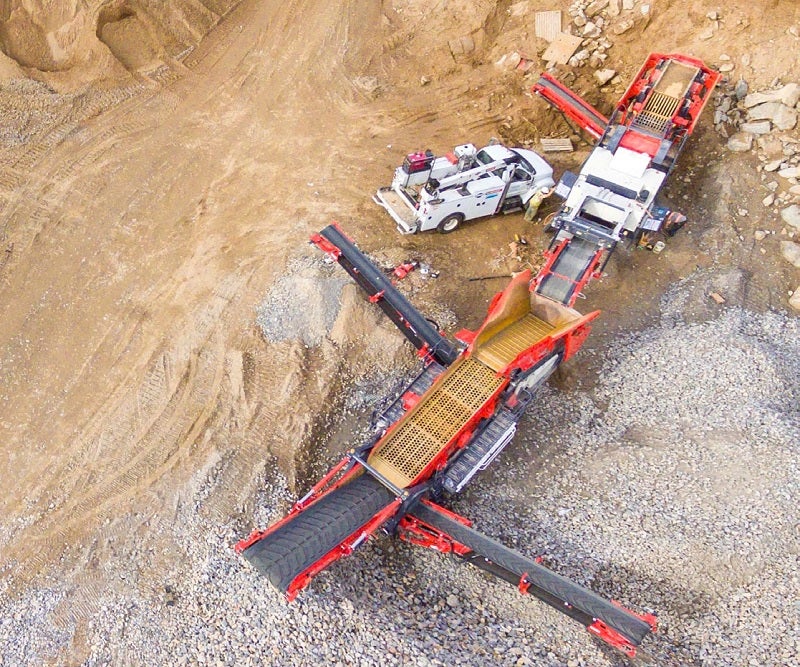
An aggregate quarry in Virginia, part of a global aggregate company, was recording its daily production with pen and paper.
With no Fleet Management System (FMS), vehicle operators were manually recording truck counts from their shifts and providing them to management for analysis, based on assumed tonnages. The time lapsed between data collection and analysis was taking an upwards of 18-24 hours, too long and too inaccurate for any significant improvements to be made.
To improve their competitive advantage, Engineering requested funding from the management team for an FMS pilot program in order to demonstrate the value and improvements an FMS provides, including cost reduction, operational performance improvement and safety improvement.
The project was approved, and the site was granted two years to demonstrate the return on investment (ROI) on the system.
The Solution
To be successful in their pilot, the site was in search of a partner that would provide them with an affordable and easily deployable end-to-end solution. In addition, the solution would require the scalability to be deployed at all the other company’s quarries, varying quite significantly in sizes.
The site had two main technical requirements:
- Requirement for an affordable production and maintenance application
- Requirement for a scalable wireless network, that reduced the entry price, while allowing them to scale as future requirements would dictate.
The site was also aware that refuelling was a time-consuming activity, often taking up to 30min/ truck/day. And, maintenance was reactive as machine health data wasn’t tracked.
Following an in-depth review of the FMS vendors in the mining industry, the quarry selected 3D-P as their end-to-end solution partner and 3D-P’s Production and Maintenance Monitoring solution, powered by iVolve, for the FMS application.
While the pilot was given two years to demonstrate the ROI of the technology, the site managed to prove it in less than a year through a combination of cost reduction and operational improvement.
The Solution: Design
Leveraging the connectivity and edge compute capabilities of the 3D-P Intelligent Endpoint® (IEP), the final solution consisted of a Rajant embedded Intelligent Endpoint running 3D-P’s Production and Maintenance Monitoring Solution, powered by iVolve, on-board. The solution was installed on-board each of their mobile equipment (trucks and loaders).
The network itself consisted of two access points for redundancy, deployed respectively at the pit edge and crusher to send the data back to the iVolve server.
- From a network perspective, the Kinetic Mesh capability of the Rajant technology provided the necessary peer-to-peer communication between trucks and loaders, without the requirement for an in-pit wireless network
- From an application perspective, the Maintenance and Production Reporting Solution provided access to a wide range of data from tonnage, circuit time, health events, etc. While the data would be provided to peer vehicles in real-time, the application running on-board the Intelligent Endpoint would leverage the edge compute capability of the platform, in particular Store and Forward, to save the data and transmit it back to the server as the vehicles would travel out the pit, back into coverage
- Information would be entered by the operator by a simple touch screen display mounted in the cab. This display would also host a pre-start application where the operator could check off or log any maintenance or safety issue observed during the initial walk around before shift begins.
The project
The project deployment consisted in the installation of a 3D-P Intelligent Endpoint and a touch screen display on three front end loaders and four end dump haul trucks. The infrastructure consisted of two Rajant ME4 Breadcrumb® radios and a PTP link between each pole, adding another layer of redundancy.
Two different trainings were delivered to the site:
- A technical training for the system administrators
- A 2-hour training with the operators on each shift, educating them on the benefits of the solution in performing their tasks.
In parallel, a weekly call was set up with the customer to review usage of the system, data produced and ways to improve their operations based on the findings.
The site administrators use iControl, 3D-P’s Production and Maintenance Reporting real time visualization piece, to monitor all their critical data remotely, including:
- Geofence location
- Vehicles’ position history
- Road conditions
- Machine health event location
- Load/Dump location
The Production Reporting solution highlighted a number of areas for potential operational improvement. Among others, the 30min/day/truck of fueling time was seen as a productivity loss, resulting in over 70 hours/month spent fueling. The site was able to quantify the time savings and prove that a fast fuel system would pay for itself in less than 90 days, after which it would help reduce non-productive time.
The Production solution also helped uncover an abnormal number of seatbelt warnings each day. As the events were time-stamped and geo-tagged to the parking area, it became clear that operators were not driving with the seat belt off, but were fastening it as they started to drive off. The problem was quickly resolved during a tailgate safety meeting highlighting the necessity for the vehicle operators to fasten their seat belts prior to operating the vehicle.
Results
While the pilot was given two years to demonstrate the ROI of the technology, the site managed to prove it in less than a year through a combination of cost reduction and operational improvement.
The company is now planning a global deployment of the solution in 2020 and 2021.

